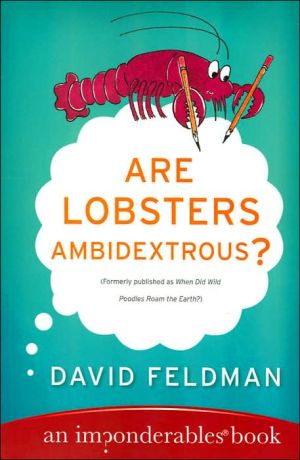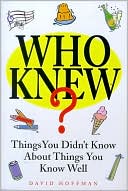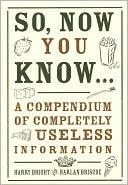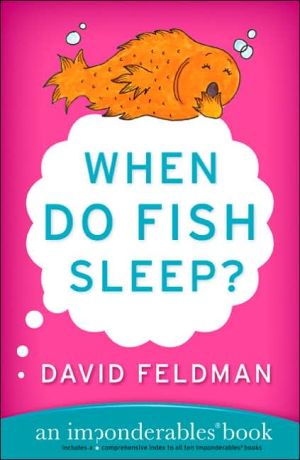Are Lobsters Ambidextrous?
Ponder, if you will ...\ Has anyone ever seen a live Cornish game hen?\ Why do quarterbacks say "Hut"?\ Why do "sea" gulls congregate in parking lots of shopping centers?\ What does the "Q" in Q-Tips stand for?\ \ Pop culture guru David Feldman demystifies these questions and much more in Are Lobsters Ambidextrous? Part of the Imponderables® series—the unchallenged source of answers to civilization's everyday mysteries—and charmingly illustrated by Kassie Schwan, this book provides you with...
Search in google:
In this reprint of the 1993 volume in the Imponderables series originally titled When Did Wild Poodles Roam the Earth?, a pop culture analyst answers questions about those irksome little mysteries of life. E.g., Feldman mines expert opinion to explain why there are no purple Christmas lights or English muffins in England. Readers comment on previous answers in the series. Annotation ©2006 Book News, Inc., Portland, OR
Are Lobsters Ambidextrous?\ An Imponderables Book \ \ By David Feldman \ HarperCollins Publishers, Inc.\ Copyright © 2005 David Feldman\ All right reserved. \ ISBN: 0060762950 \ \ \ \ Chapter One\ \ \ Are lobsters ambidextrous?\ Have you ever noticed, while digging into a lobster, that one claw is significantly larger than the other, as if one claw was pumping iron and taking steroids, while the other claw was used only for riffling the pages of library books? The large claw is called the "crusher" and the smaller one the "cutter" (terms that sound like the members of a new tag team in the World Wrestling Federation). The crusher has broader and bigger teeth but moves relatively slowly. The cutter has tiny, serrated teeth and moves swiftly.\ The two claws do not start out distinctly different. Lobsters shed their shells more often than Cher has plastic surgery -- they undergo three molts in the larval stage alone. When lobsters are first hatched, the two claws look identical, but with each successive stage in their development, the differences become more pronounced. It isn't until their fifth molt, and second postlarval molt, that the two claws are truly differentiated.\ As you may have guessed, the crusher claw is important for the defense of lobsters against predators, and the cutter particularly useful in eating. Claws of lobsters are often torn off in accidents and in fights. Although there are some differences among species of lobsters, most lobsters will regenerate severed claws.\ Most bizarre of all, if the remaining claw of an injured lobster is a cutter, many species with "plastic dimorphism" will change the function of that claw from cutter to crusher, presumably because the crusher is more essential for survival. The next regenerated claw of that lobster is capable itself of shifting to the cutter function, so that the positions of the two claws are reversed.\ According to Darryl Felder, chairman of the University of Louisiana, Lafayette, biology department, lobsters are not always right- or left-"handed." The crusher may be on the right or left side of a lobster.\ The ultimate answer to this Imponderable depends upon how you define ambidextrous. Certainly, lobsters can use either cheliped (the scientific name for claw) with equal ease. Although their regenerative powers give lobsters a certain flexibility, the versatility of each claw is not as great as that of a switch hitter in baseball, who can swing the bat equally well from both sides, or the pickpocket who can pilfer skillfully with either hand.\ Submitted by Danny Kotok of New York, New York.\ Why is there no Betty Rubble character in Flmtstones Multivitamins?\ For reasons too unfathomable for even us to delve into, we are thrown this question periodically on radio phone-in shows but have never received it in a letter. Perhaps no one wants to take credit for asking this Imponderable. One radio host said that he had investigated the matter, and found that for technical reasons, it was difficult to manufacture a realistic Betty facsimile.\ Ah, we wish that were true, but the real story is far sadder, far darker. We heard from William D. Turpin, director of consumer relations for Multivitamins' manufacturer, Miles, Inc.:\ The current group of Flintstones characters was selected based upon research of the popularity of each character with children. As a result of this research, it was determined that Betty Rubble is not as popular with the majority of the children as the other characters.\ Thus, if you investigate the contents of a Flintstones Multivitamins jar carefully, you'll find seven different "characters." As expected, Wilma, Fred, and a lonely Barney are included. Bamm-Bamm, Pebbles, and Dino are there, too, to help round out the nuclear family. But the Flintmobile? Is a car really more popular with children than a fine specimen of womanhood? You'd better believe it.\ Truth be told, Betty was never our favorite character either. In fact, we don't think she deserved a great catch like Barney. Nevertheless, her lack of charisma is hardly reason enough to break up the family units that helped make the Flintstones a television and multivitamin supplement institution.\ What in the heck is a tumbleweed? Why does it tumble? And how can it reproduce if it doesn't stay in one place?\ Three Imponderables for the price of one. The first part is easy. The most common form of tumbleweed, the one you see wreaking havoc in movie westerns, is the Russian thistle. But actually the term is applied to any plant that rolls with the wind, drops its seed as it tumbles, and possesses panicles (branched flower clusters) that break off.\ Usually, the stems of tumbleweed dry up and snap away from their roots in late fall, when the seeds are ripe and the leaves dying. Although tumbleweeds cannot walk or fly on their own, they are configured to move with the wind. The aboveground portion of the thistle is shaped like a flattened globe, so it can roll more easily than other plants.\ In his March 1991 Scientific American article "Tumbleweed," James Young points out how tumbleweed has adapted to the arid conditions of the Great Plains. One Russian thistle plant can contain a quarter of a million seeds. Even these impressive amounts of seeds will not reproduce efficiently if dumped all at once. But the flowers, which bloom in the summer, are wedged in the axil between the leaves and the stem, so that their seeds don't fall out as soon as they are subjected to their first tumbles. In effect, the seeds are dispersed sparingly by the natural equivalent of time-release capsules, assuring wide dissemination.\ Young points out that tumbleweed actually thrives on solitude. If tumbleweed bumps into another plant, or thick, tall grass, it becomes lodged there, and birds and small animals find and eat the seeds:\ Hence, successful germination, establishment of seedlings, and flowering depend on dispersal to sites where competition is minimal: Russian thistle would rather tumble than fight.\ Although songs have romanticized the tumbleweed, do not forget that the last word in "tumbleweed" is "weed." In fact, if the Russian thistle had been discovered in our . . .\ Submitted by Placido Garcia of Albuquerque, New Mexico.\ \ \ Continues... \ \ \ \ Excerpted from Are Lobsters Ambidextrous? by David Feldman Copyright © 2005 by David Feldman. Excerpted by permission.\ All rights reserved. No part of this excerpt may be reproduced or reprinted without permission in writing from the publisher.\ Excerpts are provided by Dial-A-Book Inc. solely for the personal use of visitors to this web site. \ \








